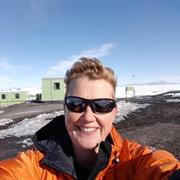This project is the first to investigate whether specific geochemical markers of global-, hemispheric-, and local-scale anthropogenic events are preserved in Adélie penguin colonies, and the potential sources of the contaminants.
Dr Tanya O'Neill has been awarded a Marsden Fund Fast-Start grant ($300,000) to investigate the long-term history of transport and accumulation of pollutants in Antarctica through the natural foraging and nesting activities of Adélie penguins.
Antarctica remains the most pristine landscape on Earth with the lowest levels of environmental pollutants sourced from human activity. Increasingly, however, contaminants such as microplastics, DDT, and heavy metals are being found in Antarctic ecosystems. Because there are few possible sources of contamination within Antarctica, they must have been transported over long distances from external sources. Recent research suggests that animals may be the most important vector for long-range transport of pollutants to the polar regions, both through their movements and through biomagnification, a process whereby toxins like mercury and lead increase in concentration as they are successively ingested by species higher on the food chain.
Penguins forage within 100 km of their colonies and, in doing so, consolidate both atmospheric and oceanic sources of pollutants. Furthermore, penguin mounds form over generations as penguins build new nests over top of previous ones. An individual nest site can record thousands of years of history. By applying a wide-range of analytical techniques to soil, bone, feather and eggshell fragments, the team will determine the concentration of mercury and lead over time. They will measure various isotopes to assess the rate that poo piles accumulate to make accurate timescale calculations as well as to identify potential sources of the contaminants.
This grant will allow Tanya to extend her current expertise and focus into a new and significant area of contaminant research. Knowledge and analytical skills learned from this Antarctic-based project can be transferred to NZ environments and afford critical insight into the life histories of persistent contaminants.
Read more details about Using penguin poo to measure contaminants in Antarctica on the Royal Society website.

Senior Research Fellow